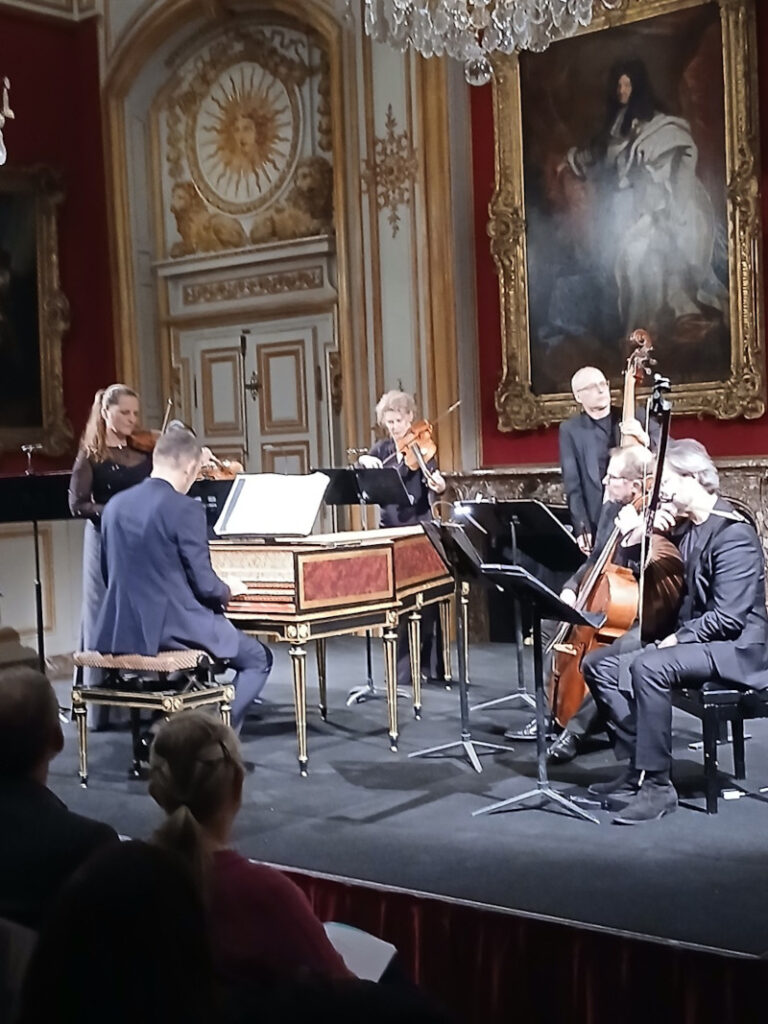Established in 2001, the French period instrument ensemble Les Paladins specialises in the performance and recording of rarely performed Baroque repertoire. The name derives from Rameau’s last comédie lyrique, and the group was founded by the conductor and harpsichordist Jérôme Correas. At the Grand Salon of the Musée de l’Armée, the players were joined by the Algerian soprano Amel Brahim-Djelloul to perform two rarely heard secular cantatas of Roman antiquity concerning the tragedy of Lucretia. In the 17th century the tale would have been known from Livy’s The Early History of Rome, and was a favourite among musicians, poets and artists includingBotticelli, Rembrandt and Titian. We may be familiar with Lucretia’s plight through Benjamin Britten’s chamber opera The Rape of Lucretia (1947) which, while regarded as a ‘problem’ work, still enjoys intermittent performances.
Probably less familiar will be this pair of works for solo voice and string ensemble by Alessandro Scarlatti and Handel – two of four works written either side of 1700 that include offerings by Benedetto Marcello and Michel Pignolet de Montéclair. These solo cantatas belong to a monumental series of works, or cantata di camera, that typically featured tragic figures such as Medea, Dido and Cleopatra. Scarlatti alone wrote no fewer than 800 cantatas for voices and modest instrumental forces.
His La Lucrezia romana dates from 1688, and its vocally demanding setting of a text by Cardinal Benedetto Pamphilj would have tested the stamina and technique of all but the most talented sopranos of the day. It presented no problems for Amel Brahim-Djelloul who sashayed with ease through its vocal challenges, underlining Lucretia’s feelings of revenge towards her aggressor, her self-hatred and a decision to take her own life, her final “Addio” cut off in one last gasp with an incomplete cadence. If Scarlatti views his Lucretia as a feisty Roman, then Brahim-Djelloul was no less spirited, her expressive delivery allied to authoritative singing. Relief from an all-consuming indignation could be heard in recurring iterations of “Ma che farai mio cor?” (“But what will you do, my heart?”) when a more yielding tone emerged. Structured around four arias, the overall sense of agitation at times felt relentless, not helped here by the soloist’s emphatic manner.

A considerable number of manuscript sources of Handel’s La Lucrezia suggest it was amongst his more popular works during his lifetime. He had gone to Italy in the autumn of 1706 intending to develop his compositional techniques, during the course of which he ‘shoplifted’ the Italian style currently in fashion in all musical and social circles. That his Italian years had a decisive influence on his output is evident in works such as Apollo e Dafne and the masterly Dixit Dominus, both works brilliantly cloning those of his contemporaries south of the Alps.Scarlatti’s La Lucrezia became a template for his own setting. Hearing the two side by side reveals just how much Handel had absorbed from his visit and how his work outclasses Scarlattti’s. Immediately apparent is a more gratifying melodic line, and a pleasing balance between rage and contemplation, tension and release more evenly distributed. The closing “Gia nel seno” encapsulates the ease with which Handel brings together heart easing melody and the drama of vocal pyrotechnics all within a single movement. Lucretia’s vow to pursue her aggressor from beyond the grave brings the work to a spectacular close. Brahim-Djelloul relished these contrasts, finding an accommodation between Handel’s furioso passages and calmer episodes in arioso movements. An uneven contest between the two composers? Handel is undoubtedly revealed as the more ambitious of the two, yet without Scarlatti’s example we might not have something so bold and enduring.
Throughout the evening, the members of Les Paladins under Jérôme Correas were sensitive collaborators and filled out the programme with two of Handel’s works from the 1730s, each given handsome performances with stylish string playing, deft fingerwork from the harpsichord and welcome changes of depth and colour from theorbo and guitar.
David Truslove
Handel – Overture and march from Ariodante HWV 33; Alessandro Scarlatti – La Lucrezia romana, H.377; Handel – Trio Sonata in G major, HWV 399; Handel – La Lucrezia, HWV 145
Amel Brahim-Djelloul – soprano; Les Paladins: Catherine Plattner & Yuna Lee – violins; Clara Mühlethaler – viola; Nicolas Crnjanski – cello; Franck Ratacjczyk – double-bass; Benjamin Narvey – theorbo & guitar; Jérôme Correas – harpsichord & director
The Grand Salon, Musée de l’Armée, Les Invalides, Paris; 17 November 2025
All photos © Les Paladins